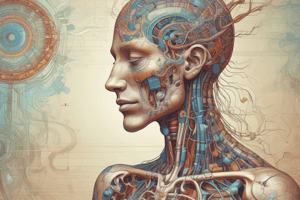Podcast
Questions and Answers
ADRENERGIC NEURONS & RECEPTORS (A) NOREPINEPHRINE (1) Synthesis Tyrosine enters the neuron through a Na channel cotransport Conversion from tyrosine to L-DOPA L-DOPA gets converted to Dopamine Dopamine gets converted to ______ inside intracellular vesicles Action potential activates voltage gated Ca++ channels
ADRENERGIC NEURONS & RECEPTORS (A) NOREPINEPHRINE (1) Synthesis Tyrosine enters the neuron through a Na channel cotransport Conversion from tyrosine to L-DOPA L-DOPA gets converted to Dopamine Dopamine gets converted to ______ inside intracellular vesicles Action potential activates voltage gated Ca++ channels
Norepinephrine
TYPES OF AGONISTS II) BETA-ADRENERGIC AGONISTS (A) BETA-1 AGONISTS (B) BETA-1+2 AGONIST (C) BETA-2 AGONIST (D) BETA-3 AGONIST III) ALPHA+BETA AGONIST (A) ______
TYPES OF AGONISTS II) BETA-ADRENERGIC AGONISTS (A) BETA-1 AGONISTS (B) BETA-1+2 AGONIST (C) BETA-2 AGONIST (D) BETA-3 AGONIST III) ALPHA+BETA AGONIST (A) ______
NOREPINEPHRINE
GRAPHICAL REPRESENTATIONS OF CVS EFFECTS OF NOREPINEPHRINE, EPINEPHRINE, & ISOPROTERENOL (A) NOREPINEPHRINE (B) EPINEPHRINE (C) ISOPROTERENOL (D) SUMMARY V) APPENDIX VI) REVIEW QUESTIONS VII) REFERENCES I) ADRENERGIC NEURONS & RECEPTORS (A) NOREPINEPHRINE (1) Synthesis Tyrosine enters the neuron through a Na channel cotransport Conversion from tyrosine to L-DOPA L-DOPA gets converted to Dopamine Dopamine gets converted to Norepinephrine inside intracellular vesicles Action potential activates voltage gated Ca++ channels (2) Receptors (i) 1 receptor o Works through the Phosphol.
GRAPHICAL REPRESENTATIONS OF CVS EFFECTS OF NOREPINEPHRINE, EPINEPHRINE, & ISOPROTERENOL (A) NOREPINEPHRINE (B) EPINEPHRINE (C) ISOPROTERENOL (D) SUMMARY V) APPENDIX VI) REVIEW QUESTIONS VII) REFERENCES I) ADRENERGIC NEURONS & RECEPTORS (A) NOREPINEPHRINE (1) Synthesis Tyrosine enters the neuron through a Na channel cotransport Conversion from tyrosine to L-DOPA L-DOPA gets converted to Dopamine Dopamine gets converted to Norepinephrine inside intracellular vesicles Action potential activates voltage gated Ca++ channels (2) Receptors (i) 1 receptor o Works through the Phosphol.
EPINEPHRINE + DOPAMINE
BETA-1+2 AGONIST (C) BETA-2 AGONIST (D) BETA-3 AGONIST III) ALPHA+BETA AGONIST (A) NOREPINEPHRINE (B) ______
BETA-1+2 AGONIST (C) BETA-2 AGONIST (D) BETA-3 AGONIST III) ALPHA+BETA AGONIST (A) NOREPINEPHRINE (B) ______
Receptors (i) 1 receptor o Works through the ______
Receptors (i) 1 receptor o Works through the ______
Which receptor works through the Phosphol?
Which receptor works through the Phosphol?
What is the final product of the synthesis of tyrosine inside adrenergic neurons?
What is the final product of the synthesis of tyrosine inside adrenergic neurons?
Which type of agonist acts on both Beta-1 and Beta-2 receptors?
Which type of agonist acts on both Beta-1 and Beta-2 receptors?
What is the neurotransmitter involved in the Alpha+Beta agonist category?
What is the neurotransmitter involved in the Alpha+Beta agonist category?
Which agonist acts specifically on the Beta-3 receptor?
Which agonist acts specifically on the Beta-3 receptor?
Flashcards are hidden until you start studying
Study Notes
Adrenergic Neurons & Receptors
- Norepinephrine is synthesized from tyrosine, which enters neurons via sodium channel cotransport.
- Tyrosine is converted to L-DOPA, then to dopamine, and finally dopamine is transformed into norepinephrine within intracellular vesicles.
- Action potentials prompt the opening of voltage-gated calcium channels.
Types of Agonists
-
Beta-Adrenergic Agonists:
- Beta-1 Agonists: Target the heart, increasing heart rate and contractility.
- Beta-1+2 Agonists: Affect both Beta-1 and Beta-2 receptors, providing a broad range of effects.
- Beta-2 Agonists: Primarily cause bronchodilation and vasodilation; used in asthma treatment.
- Beta-3 Agonists: Involved in promoting lipolysis and regulating energy expenditure.
-
Alpha+Beta Agonists: Exhibit both alpha and beta adrenergic activity, impacting various physiological responses.
Norepinephrine, Epinephrine, & Isoproterenol
- Norepinephrine has distinct cardiovascular effects compared to epinephrine and isoproterenol.
- Epinephrine generally has a broader range of systemic effects than norepinephrine, influencing both alpha and beta receptors.
- Isoproterenol primarily targets beta receptors, increasing heart rate and decreasing peripheral resistance.
Receptors
- Alpha-1 Receptor: Functions through phospholipase C, resulting in increased intracellular calcium and vasoconstriction.
- Understanding the various receptor types is crucial for pharmacological targeting in cardiovascular and respiratory therapies.
Summary
- Norepinephrine synthesis and its subsequent actions through specific adrenergic receptors play a vital role in autonomic nervous system responses.
- Different agonists have unique effects on cardiovascular and respiratory systems based on their receptor specificity.
Studying That Suits You
Use AI to generate personalized quizzes and flashcards to suit your learning preferences.




